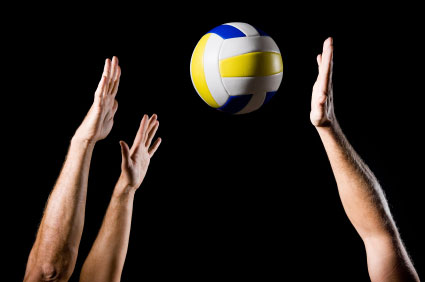Archive for Volleyball Tips
Effective Volleyball Shot Blocking Tips from Springbak
Posted by: | Comments Among all the frustrating volleyball scenarios, perhaps none is worse than having a hitter get the ball by you again
and again
and again. It can get so bad that you feel that what you’re doing isn’t blocking but simply getting extra jumping practice.
Among all the frustrating volleyball scenarios, perhaps none is worse than having a hitter get the ball by you again
and again
and again. It can get so bad that you feel that what you’re doing isn’t blocking but simply getting extra jumping practice.
If that sounds familiar, believe it or not, there is hope. While it’s true that blocking is somewhat helped by height, arm length and vertical leap, technique and smarts also play a big role.
Here are a few tips on how to block almost any hitter in almost any situation:
One key to successful blocking is to build a solid barrier that extends over the net – even if it just means getting your hands across the net. As you reach over, there should be as little space as possible between your arms and the top of the net. If you can create a tight ‘seal’ with the net without touching it, you’ll make it impossible (or almost) for the hitter to bang a ball off your hands and force it to dribble down your body on your side of the net. To create a seal, remember to achieve full extension of your arms (elbows locked, shoulders shrugged, head down with eyes up) and reach over the net as fast as you can. Even if you only get your wrists and hands over the net, its better to create a seal than to make your hands a flat up-and-down wall.
Think ‘shield’, not ‘weapon’. While technically a block is a defensive weapon, it helps to think of the blocking action as a shield or a force field against a hitter, not an offensive maneuver. Many people try to attack the ball when they block, slapping at their opponent’s hit as it crosses the net. This can produce an undesirable result: it unseals the top of the net; it’s a low-percentage opportunity because you have to time your slap exactly right to reject your opponent’s hit; you can’t guide the ball where you want it upon contact; and it’s very difficult for your teammates to line up for defense behind you. So, instead, think of yourself as an impenetrable wall or force field. You’re an immovable object set in place to repel the force of the ball. Extend far over the net, hold that block as long as possible, and try to line yourself up so the ball rebounds off your ‘wall’.
Different players have different preferences about how wide they’ll spread their arms during a block. This also varies from a single block to a double block. In a double, the width is generally less than with a single block. Assuming you’re solo blocking, keep your hands about a ball-width apart, with your fingers spread and rigid to create the most surface area. Your thumbs should not touch. If they do, your hands are TOO close together. A comfortable distance might be four to six inches between your thumbs if you have small hands, and a little wider if you have big hands. If your hands are too close together, you’re not taking away enough space from your opponent. If your hands are too far apart, you’re inviting your opponent to score a field goal by blasting the ball through the opening. Ouch! This is a matter of adjustment, and it’s often helpful to ask your coach or teammates for feedback on your positioning. Always get feedback from your coach, he/she wants you to ask!
Many blockers make the mistake of watching only the hitter, but the set can tell you much more about what kind of attack is coming. Is the ball far off the net? That means the hitter probably can’t hit straight down and will have a slightly slower/delayed approach, since he’ll most likely have to adjust his footwork. This means you need to begin your block jump a bit later and reach high. Is the set close to the net? By all means, make sure you get maximum penetration. A low set? Get ready to jump sooner. Naturally, the hitter can also give you information. Watch the angle of his approach. This can tell you where to line up as he begins his hitting motions.
Watch his shoulder and upper body. Is there a lot of rotation? He may be preparing to hit across his body.
Does his shoulder or elbow drop? A shot might be coming. Learning to read these clues can make your blocking decision a whole lot easier.
Final thoughts. Sometimes, no matter what you do, there will be a hitter who seems unblockable. If you’re facing a 6-9 hitter and you’re 5-8, it’s possible that despite your best intentions, form, and attention to detail, he’ll still hit over you. But the tips above should help you match up better for most game situations.
Dave Richard, Head Coach Utah Valley University Men’s Volleyball – “This 2009 season, I personally tested the vertical leap of my six starters. They averaged 32 inches and 38 inches in their vertical leap. They averaged 3 inches higher after inserting Springbak® Springsoles in their shoes, increasing their average vertical leaps to between 35 inches and 41 inches.”
Enjoy the volleyball tips and best of luck this season to all our sponsored Universities and Club Teams.
Mark Vona – GM Springbak, Inc.
Visit the Official Springbak® Website at www.springbak.net – Peak Performance Springsoles / Insoles – Run Faster, Jump Higher, Lessen Fatigue
LIKE us on Facebook: www.facebook.com/springbak
Tweet with us on Twitter: www.twitter.com/springbak
Friend us on MySpace: www.myspace.com/springbak
Tune in on YouTube: www.youtube.com/springbakinc
Springbak Volleyball Conditioning Drills: What Kind of Training is Needed?
Posted by: | CommentsStrength/Power Training – How to Gain Strength for Volleyball?
 Beginning volleyball players are able to gain strength by working out with the body weight, but in order to get to the next level athletes need to start weight training.
Beginning volleyball players are able to gain strength by working out with the body weight, but in order to get to the next level athletes need to start weight training.
One of the best methods to get strength is the basic weight training in the gym. Traditional weight lifting exercises like squats, deadlifts, clean and jerk, snatches, bench press and all the variations of them are great exercises for volleyball players.
Weight training doesn’t necessary mean traditional weight lifting. It could include training with medicine balls, kettle bells or any extra weight you can imagine.
Pure Power Alone Is Not Enough
Pure power and strength alone doesn’t carry very far on the volleyball court – volleyball players also need endurance, agility and quickness on the court.
Being Explosive and Quick Is Important
When working out it is extremely important to keep in mind what qualities is needed in volleyball.
For example being explosive and quick is important for volleyball players, therefore an athete should always have explosive power training or quickness training in the training schedule.
Volleyball Conditioning Drills – Endurance Training
What kind of conditioning is needed in volleyball?
Let’s think about the volleyball match – each rally is about 5-15 seconds long, following with 5-10 second break between the rallies. Wouldn’t it make sense to practice endurance in that context?
Therefore traditional cardio, like long distance running is probably not the best training for volleyball endurance. It will surely increase athletes’ VO2 max, but still there is a better way..
Engage athletes for example in plyometrics training (low impact jumps, footwork drills, ladder drills, dot drills, etc.), in which athlete works that 5-15 seconds intensively, then having a little 5-10 break between each rep. That kind of training makes athlete work out with the same energy levels than needed in volleyball.
Surely you could add also higher intensity interval training into the mix – making athletes taking for example 15 second sprints following by jogging/walking before doing another sprint. You could make that happen on the volleyball court by running volleyball suicides – making sure athletes have to change direction often, just like in the volleyball match.
Volleyball Conditioning Drills – Agility Training
How to get quick feet and become fast on the court?
Plyometric exercises involve usually to short and quick movements, which athlete performs often with own body weight in a circuit type of training.
Plyometric exercises are great way to improve agility and help athletes to change direction quickly.
Ballistic training is very close to plyometrics training and often referred as plyometrics. Explosive push ups, squat jumps, frog jumps, medicine ball throws are ballistic or plyometric exercises which are excellent for volleyball players.
Next week we will cover Spiking Fundamentals : by Hugh McCutcheon, head coach USA Volleyball
_____
For more tips and information:
Visit the Official Springbak® Website at www.springbak.net
Peak Performance Springsoles / Insoles – Run Faster, Jump Higher, Lessen Fatigue
Find us on Facebook: www.facebook.com/springbak
Follow us on Twitter: www.twitter.com/springbak
Friend us on MySpace: www.myspace.com/springbak
Tune in on YouTube: www.youtube.com/springbakinc
Volleyball Jump Training
Posted by: | CommentsWe hear these techniques from world class athletes and trainers all the time, there must be something here. The most important part of volleyball training is proper training. If an athlete jumps repeatedly with poor technique, they can seriously injure themselves. A good volleyball coach or trainer seems to always emphasize the importance of maintaining proper technique at all times.
When volleyball jump training, athletes should keep their knees directly in line with their ankles and not allow the knees to bend over further, reaching to where they are in line with their toes. This position puts stress on the knee, an already fragile part of the body. If athletes feel that they cannot get low enough in the sit before the jump, they should either widen their feet or lean further forward, allowing their rear to extend further back, while keeping a straight back.
Besides keeping the knees in line with the ankles, athletes should ensure that they are pushing off from the whole foot. Doing so ensures that athletes get full power in their jump and are not killing the height of the jump. When jumping, athletes should strive to leave the floor from the middle of the foot or the ball of the foot for maximum vertical.
Finally, athletes should land by rolling through the foot. This protects the knees and ensures stability as athletes move from jumping into another activity. The best way to land a jump properly is to allow the foot to land naturally in the air, with the toes down. This puts the athlete in the proper  position to land the jump.
position to land the jump.
We want you, the athletes, to give us comments here about your successful routine of volleyball training for proper technique and maximum vertical jumping ability.






















